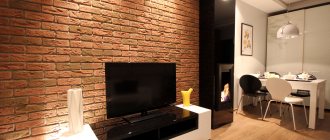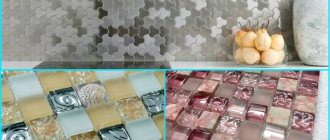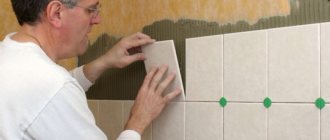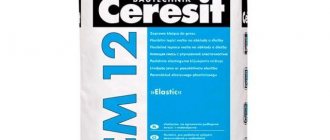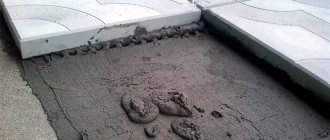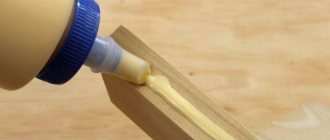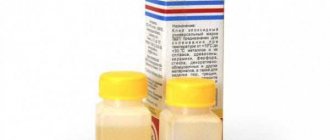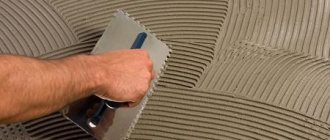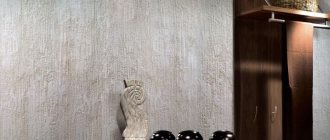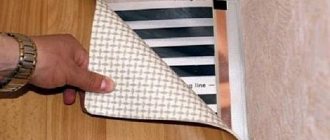How to choose adhesive for heated floors
Adhesive compositions suitable for laying tiles over underfloor heating systems have special markings on the packaging. Usually this is a snowflake with the sun - a sign indicating the resistance of the adhesive to temperature changes. Instead of an icon, there may simply be an inscription on the package “the adhesive is suitable for the “warm floor” system.”
Marking option
Why do you need special glue?
During operation, a warm floor causes heating of all elements of the floor covering. Materials expand when heated and contract when cooled. The adhesive composition on which tiles or porcelain tiles are laid behaves in a similar way. This is why regular adhesive is not suitable for installing heated floors: it will quickly crack due to its low elasticity during regular heating and cooling.
With a single strong heating, simple glue can completely separate from the surface and crumble. Deterioration of the adhesive composition entails the accumulation of air in the cracks, due to which thermal conductivity decreases.
How to avoid these problems? It is necessary to choose specialized tile compositions that can easily withstand temperature changes within the range of -30... +100 degrees. They have high elasticity, reliably fasten any rough base material (concrete, wood) with finishing, and do not change the thermal conductivity of the entire structure. Adhesives are dry mixtures that must be properly diluted before use, or ready-made canned products.
What is glue used for?
Elastic, heat-resistant adhesive can be used in most types of underfloor heating systems by direct application to heating elements. However, film (infrared) type floors require the use of leveling mixtures before gluing. Otherwise, there is a risk of destruction of system elements, which will quickly fail. When purchasing glue, you need to make sure that it is suitable for a specific type of system, which is always indicated on the packaging.
Thick and thin layer adhesives
Cladding tiles can be laid using different types of adhesive solutions.
They are divided into forming
- Thick layer;
- Thin layer.
Glue made using resinous substances is applied to the plasterboard base planes. The layer of such a reagent should have a thickness ranging from 3 to 5 mm.
Types of floors
There are three types of heated floors: water, electric, infrared. They differ in operating principles and characteristics.
Electric floors
This type of flooring is widespread. When installing the system, a single-core or two-core ultra-thin cable is installed directly under the tile. The advantage of the floor is the ability to install it on an old screed. However, it must be level, without differences, and also have sufficient height (4-5 cm), otherwise the system will not last long.
Water floors
In this system, heating is carried out by circulating hot water in the pipes. During installation, the heated floor is supplied to the central heating system, so in the future it causes virtually no maintenance costs. Over time, the system tubes may become clogged due to deposits, so it is better to immediately install a filter device to prevent clogging.
Infrared floors
In appearance, such floors are a polymer film in the form of 50*50 cm modules. Heating elements are located inside each module. Infrared floors are very economical in terms of energy costs. The only downside is a decrease in efficiency when laying under ceramic tiles and porcelain stoneware: infrared radiation from under these materials is poor.
IQ Floor Mat 1.5 sq.m.
| Manufacturer: | IQ WATT |
| View: | heating mat |
| Power: | 225 W |
| Heating area: | 1.5 m2 |
| Installation type: | into a layer of tile adhesive |
for comparison
RUB 6,580
Product added to cart
| Photo | Name | Price per piece | Quantity | Price |
| IQ Floor Mat 1.5 sq.m. | 6,580 rub. | < 1 > | 6,580 6,580 rub. |
There are 0 items in the cart worth 0 rub.
Go to cart
Buy
Availability
Go to the full catalog of IQWATT heating mats
You can get advice, additional information about heating mats and choose a heated floor for tiles in our online store, by calling +78.0 or in one of our stores in your city.
Classification of materials by composition
Construction stores sell three types of adhesive mixtures that are suitable for underfloor heating systems. They are classified depending on the main component. All adhesives necessarily contain plasticizers, which enhance elasticity and help maintain adhesive properties during expansion and contraction.
One-component adhesives
Polymer one-component compositions are sold in finished form, they are packaged in plastic jars, buckets, and are a thick paste. The adhesives contain synthetic resins and modifiers. Glues have a fairly long pot life, so they are well suited for beginning craftsmen. The downside is the high price.
Two-component
Two-component adhesives are made on the basis of polyurethane or epoxy resin. Both substances gain hardness only after the introduction of a hardener, which starts the polymerization reaction. Therefore, when laying a heated floor, you need to mix a small batch of glue at a time in order to have time to use it. Epoxy adhesives are more expensive than polyurethane adhesives, but both types of products are characterized by a high degree of adhesion and good elasticity.
Cement based
Adhesives based on cement, fine sand, and modifiers are considered the most popular when installing heated floors. They are a dry mixture that must be diluted with water before use. The cement hardening time is short, so you need to try to work faster or dilute small batches of glue.
Characteristics of adhesive compositions
Before purchasing, you need to carefully read the information on the packaging of a particular product. The adhesive must meet a number of characteristics, otherwise it will not be suitable for underfloor heating systems:
- resistance to temperature changes (at least -30...+100 degrees), including up to critical temperatures;
- adhesion from 0.5-1 MPa;
- compatibility with coating and base materials;
- high elasticity;
- ease of application.
Thermomat 130 1.5 sq.m.
| Manufacturer: | Thermo |
| Model: | TVK-130 |
| View: | heating mat |
| Power: | 190 W |
| Heating area: | 1.5 m2 |
| Installation type: | into a layer of tile adhesive |
for comparison
old price 8,113 rub.
RUB 7,302
Product added to cart
| Photo | Name | Price per piece | Quantity | Price |
| Thermomat 130 1.5 sq.m. | 7,302 rub. | < 1 > | 7,302 7,302 rub. |
There are 0 items in the cart worth 0 rub.
Go to cart
Buy
Availability
Go to the full catalog of THERMO heating mats
Criteria for choosing adhesive for tiles under heated floors
When selecting adhesive for installing tiles, you must take into account the type of facing material. A good adhesive is resistant to slipping of large tiles and very heavy elements. There should be no stains left on tiles, porcelain tiles, or marble, and no efflorescence should appear during the operation of the heated floor.
If the product is to be used in the bathroom, it must be resistant to high humidity and contain antifungal components.
For outdoor work, special compounds are used for anti-icing systems, which additionally have frost resistance. If there is a need to level the base, self-leveling mixtures with heat-resistant properties and sufficient elasticity are used. Also, when purchasing glue, you should take into account the manufacturers’ ratings and purchase only a proven brand that boasts excellent quality.
What tools are needed?
Below is a detailed list of tools that will be useful to you when laying tiles.
- Construction spatula with teeth.
- Heated floor adhesive.
- Trowel, brushes, ladle.
- Deep priming agent (it is better to choose the same brand as the selected glue).
- Mixer.
- Containers for diluting glue.
- Tile cutter
- Level.
- Material for cladding.
- Rubber hammer.
You need to prepare all the tools for laying tiles in advance
Having prepared all the above materials, we proceed to installation.
Tile laying technology
It is easiest to install a floor when its heating elements are made in the form of laid mats. In this case, there is no need to perform a screed on top of the system, which is necessary in all other options. When laying tiles on mats, you need to give them additional rigidity and cover the cables, which glue successfully does. After the glue has dried, begin laying the tiles.
If you have to install a concrete screed, durable cement or special self-leveling mixtures are used for this purpose. According to the standards for laying tiles, height differences should not be more than 2 mm for every 2 meters of finished screed. After pouring, you need to wait until the screed dries completely (from a week to 2 months depending on the thickness). Next you can start laying the tiles:
- clean the surface, remove all debris and dirt from it;
- apply glue to the surface using a notched trowel, level it, forming grooves;
- Lay the tile and adjust its position within 10-15 minutes.
You should not apply glue to a large area of the floor at one time; usually, applying the product to 1 square meter is enough to have time to stick the tiles. When facing, it is imperative to observe technological seams, which will prevent the material from deforming and help avoid damage due to expansion during heating. Usually, when laying, crosses are used, which are removed after completing the work. The seams are grouted a day after tiling the floor, and they begin to use only after waiting for the glue to completely dry (5-30 days).
Required glue thickness
The thickness of the adhesive layer can vary and is calculated depending on the instructions of the manufacturer of the heated floor system. Most often it is recommended to make a layer of 3-5 mm, which can be easily done with a notched trowel with a tooth height of 1 cm.
If a system in the form of mats is used, first it is fixed with a minimum amount of glue, and then a spatula with 0.8 cm teeth is used. For large slabs, a layer of at least 6-7 mm is applied, and the glue is applied both to the floor and to the back side of the tile .
Since heat-resistant adhesives have good insulating properties, you should not exceed the recommended thickness of the product - this will reduce the quality of heating of the floor covering.
Grout for heated floors
It is advisable to purchase grout from the same manufacturer as the glue. It should also be elastic and easily withstand temperature changes. The color is selected in harmony with the main tone of the tile. The joints between the wall and the floor are sealed with silicone compounds that are not subject to cracking. It is prohibited to use simple cement-sand mixtures for grouting joints that do not meet the requirements for the use of heated floor systems.
Warmstad 1.5 sq.m.
| Manufacturer: | Warmstad |
| View: | heating mat |
| Power: | 220 W |
| Heating area: | 1.5 m2 |
| Installation type: | into a layer of tile adhesive |
for comparison
RUB 2,907
Product added to cart
| Photo | Name | Price per piece | Quantity | Price |
| Warmstad 1.5 sq.m. | 2,907 rub. | < 1 > | 2,907 2,907 rub. |
There are 0 items in the cart worth 0 rub.
Go to cart
Buy
Availability
Go to the full catalog of WARMSTAD heating mats
Mistakes when laying tiles on a heated floor
To improve the quality of the finished coating, you need to follow the advice of experts and eliminate common mistakes.
Expansion joints
The seams compensate for the linear expansion of the subfloor during heating and cooling. The grout shrinks under the influence of physical factors, and the tiles in the area of the damper joint (between the wall and the floor) can separate, because the vibrations sometimes amount to several millimeters. Even the most elastic material is not able to smooth out such a deficiency, so tilers use special techniques.
To seal a damper joint, you can use a special layout of tiles so that only the edges fall on the joint, but this negatively affects the overall layout of the coating. It is also possible to seal the seams only with silicone sealant, but it often differs in color from the main grout. It is better to smear part of the tile with glue directly above the damper joint, and treat the rest of the material with sealant; as a result, the correct layout of the slabs will not be disrupted.
Wrong choice of glue
Manufacturers also produce so-called “universal” adhesives that can be used on most substrates: from concrete, OSB boards to drywall and heated floors. Most often, the adhesion of such compositions is lower than that of specialized mixtures that are intended for a specific building material. It is better to choose a truly suitable adhesive, which is especially important when laying smooth porcelain tiles.
Defective tiles
In stores, tile defects are rare, but sometimes you can get caught. Usually there are deviations in the shape and thickness of porcelain stoneware. Detecting a problem before gluing the slabs will allow you to immediately correct the situation by increasing the thickness of the glue and using the correct layout. If the tile is curved, it is better not to use it at all. Elements of non-standard size are most reliably glued with a herringbone layout.
Dry glue left in open bag
All tile adhesives are quite hygroscopic, but they can be preserved even when opened for 14-20 days. To do this, you need to remove the air from the bag as thoroughly as possible and wrap the packaging in a plastic bag in several layers. The bag should be stored in a room with low humidity and temperature. After 1-2 months, the glue will still have to be thrown away if it remains unclaimed.
The glue on the ridges has dried out
You should not lay tiles on dried adhesive, which is not able to provide a sufficient level of adhesion. You just need to take a notched spatula, run it over the glue a couple of times and apply a little fresh product. Excess should be removed from the tiles.
Stepping on uncured glue
Walking on a surface that is not completely dry should not be allowed. If this happens, you should remove the tiles from the floor surface. To avoid damage to adjacent elements, you need to place an OSB board or board on the floor, which will increase the support area and help prevent further displacement of the slabs. Afterwards, you need to remove the shifted element, clean off the glue and repeat the installation again.
Popular tile adhesive brands and manufacturers
Builders prefer to use proven adhesives from the brands Axton, Bergauf, Ceresit, Litokol and others. The most popular means are described below.
Ceresit
The manufacturer of products under the Ceresit brand is the German company Henkel, which has long enjoyed the high trust of craftsmen. All products are produced taking into account environmental standards; they do not contain harmful components, therefore they can be used indoors and do not emit fumes after heating.
The following adhesives can be used for tiles:
- SM16;
- SM117;
- SM17;
- CM14 EXTRA.
The last glue mentioned is used most often. It allows you to work at temperatures of +5...+30 degrees, has long periods of solution viability and tile adjustment (2 hours and 20 minutes, respectively). The level of glue adhesion is 0.8 MPa, operating temperatures are from -30 to +70 degrees. A day after installation, you can start grouting the joints on the tiles.
Bergauf
Bergauf building mixtures are of excellent quality. They are produced by the German-Russian company of the same name and include a whole line of products for working with tiles. For underfloor heating, Keramik Express is usually used - a quick-drying adhesive that cures in 4 hours.
You need to work with glue quickly: a portion retains its properties for 45 minutes, the time for adjustment is only 10 minutes. The product can withstand heating up to +70 degrees and cooling down to -10 degrees. Typically, glue is used on cement, concrete screed, including in the bathroom.
Knauf
Adhesives of this brand are also produced in Germany. The best product for underfloor heating is Knauf Flex - a dry cement mixture with high adhesion and elasticity. With its help, you can easily lay tiles even on gypsum fiber and old ceramics. The glue has good performance in terms of temperature of use (-30...+80 degrees) and adhesion (1 MPa).
The product has excellent water resistance, allowing even beginners to work with it, because the solution’s lifetime is 3 hours. The glue dries in two days, after this time the joints can be grouted. Before installing the heated floor, be sure to apply Knauf Flachendicht primer to the base.
Litokol
Litokol brand adhesives are produced in Russia. For heated floors, you can purchase Litoflex K80, which is a dry, finely dispersed cement mixture. The glue has the longest time to adjust the position of the elements - 1 hour, which is why beginners prefer to buy it. It can withstand temperatures up to +90 degrees, which is ideal for underfloor heating systems.
There is one more product in this company’s line of tile products that is suitable for heated floors. This is Litoelastic, a two-component polymer composition that is mixed immediately before use. It dries within 24 hours, gives only 45 minutes to adjust the tiles, but can withstand temperatures of -40...+100 degrees and has very high elasticity.
Unis
The Russian manufacturer Unis produces Unis Plus adhesive, which is perfect for underfloor heating systems. It has one of the highest adhesion rates - 1.25 MPa, is considered an environmentally friendly product, and is therefore widely used in children's institutions. The solution can be applied within 3 hours, but only 10 minutes are given to correct flaws in the position of the tile. The glue can withstand operating temperatures of -50…+70 degrees. You can walk on the finished surface after 24 hours. Due to high adhesion, it is not recommended to use glue on deformable substrates.
